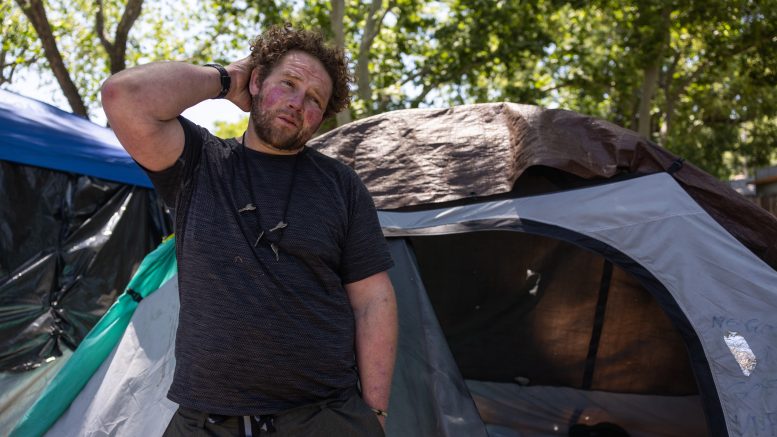By Chris Nichols, CapRadio
Six months after Sacramento’s voter-approved ban on homeless encampments went into effect, supporters and critics of Measure O say the controversial new city law has done little to improve the crisis on streets. Some are hopeful that will change.
Still, the lack of early progress is striking: City officials said they have yet to clear a single encampment, issued only one citation and connected just 55 people to shelter under the measure from January through May, the first five months for which the city has tracked data.
Meanwhile, thousands of unhoused residents continue to camp along city sidewalks, parks and riverbanks.
Measure O, also known as the Emergency Shelter and Enforcement Act of 2022, was passed by 52% of city voters in November. It prohibits camping on public property and includes a misdemeanor fine for people who refuse to move after they are offered available shelter.
It also requires the city to create hundreds of new shelter spaces to address its severe shortage. Without those spaces, city officials can’t fully enforce the measure.
Daniel Conway, who led the Yes on Measure O campaign, said he’s not bothered yet by the slow pace of progress. He won’t judge the measure’s success, he added, by the number of citations issued or dollars spent.
“The goal here is to create places for people to go other than encampments so that people have that opportunity,” Conway said, “and so that we can begin to clean up and reduce encampments.”
He urged the city to ramp up its efforts to connect people with shelter.
“Right now, I’m willing to be patient,” Conway said. “But if we’re still having this conversation in three to six months, then, yeah, it’s a different conversation because we can’t wait forever.”
Voters passed Measure O just months after Sacramento County’s homeless population hit a record 9,300 people last year. A volunteer-led survey called the 2022 Homeless Point-In-Time Count found more than 1,600 tents and 1,100 vehicles being used as shelter, totals that were five times larger than the previous count in 2019.
The survey tallied more than 5,000 individuals living within city limits in either a tent, vehicle, abandoned building or other location considered not suitable for human habitation.
Why is it taking Sacramento so long to enforce Measure O?
With the measure’s approval, Sacramento joined a growing list of California cities that have banned encampments in certain public spaces amid the state’s worsening homelessness emergency.
Los Angeles, Oakland, Santa Cruz and Elk Grove all passed similar laws in recent years. San Diego passed its own ban last week.
But like those other cities, Sacramento is now struggling to open enough shelters to enforce its new law, all as encampments push deeper into residential and business districts citywide.
Measure O required the city to “identify and authorize” at least 605 individual shelter spaces by March — something officials say they’ve technically done — and hundreds more in subsequent months once new spaces fill up. The initiative defines a space as a bed for one person in a traditional indoor shelter or a place for a tent or vehicle at a sanctioned outdoor shelter.
Creating that additional capacity would be a huge boost to Sacramento’s existing 1,100 shelter beds, which are typically full on any given night.
But many of the new spaces identified by the city exist only on paper. Some have been delayed while others are in the early planning stages, meaning Sacramento’s lack of shelter won’t be solved soon.
“I get the frustration that’s out there,” Mario Lara, Sacramento’s assistant city manager said. “But we are using all available resources to help resolve the issue.”
Both the voter initiative and a 2018 federal court ruling known as Martin v. Boise requires the city to offer available shelter space before unhoused residents can be asked to move from many public spaces or fined.
There are exceptions. People living within 500 feet of schools and child care centers and those in tents blocking sidewalks can be fined or forced to relocate without the offer of shelter, under separate laws passed by the Sacramento City Council last year.
While city officials say they haven’t removed any camps under Measure O, advocates for unhoused residents say Caltrans and county officials have continued to force people to move from state and county-owned land.
In addition, the city has continued to tow illegally parked vehicles, including some used as shelter by unhoused residents, advocates noted.
‘Falling way short’
While it might not be visible on the street, Lara said Sacramento is technically “complying” with Measure O because it has “identified and authorized” 705 shelter spaces.
“A large number of those are still works in progress,” Lara explained.
Notably, the city is counting 350 tiny homes Gov. Gavin Newsom promised the region in March, with the goal of opening by this fall. On the day of that announcement, Mayor Darrell Steinberg said some of the shelters would be placed at the Cal Expo fairgrounds, though few details have been released.
Last month, Steinberg said those tiny homes won’t open until late this year or early next. If that happens, they would join a long list of delayed shelter projects across the region, including two separate tiny home projects planned for South Sacramento.
Along with counting future plans, Measure O also allows the city to count shelter spaces as “new” even if they were authorized more than two years ago. As a result, Lara said the city can include last year’s expansion of two shelters and the creation of a motel shelter program. Combined, those projects added approximately 200 spaces to the city’s inventory, he noted.
Even so, critics say those efforts don’t come close to matching the scale or urgency of Sacramento’s homelessness problem.
“They’re falling way short of that [605 space requirement],” said Bob Erlenbusch, who directs the Sacramento Regional Coalition to End Homelessness. “They don’t have the capacity for shelter or treatment slots to really make an impact in our community in a humane way.”
Erlenbusch and other homeless advocates opposed the ballot measure, saying it would criminalize living on the streets and harm unhoused residents by separating them from the existing resource networks.
But Measure O passed with the support of business and neighborhood groups who said they wanted to force the city to take action after years of letting the problem spiral and watching quality of life decline.
Sacramento City Councilmember Katie Valenzuela, who also opposed the initiative, said she’s not surprised the enforcement numbers are so low given the lack of shelter capacity and delays in opening new projects.
“You can’t take someone [off the street] when there’s nowhere to take them,” said Valenzuela. “That is the step you are stuck at” with Measure O.
‘The key piece of Measure O’
Supporters and critics alike say Measure O has produced one important change: It has forced Sacramento’s city and county governments to work together to tackle the region’s homelessness crisis, after years of confronting it separately.
Before the City Council agreed to place the measure on the ballot last year, Steinberg requested that it include a provision that the two agencies sign a partnership agreement to work together. The language required the agencies to sign the deal before Measure O could go into effect. They did so in December.
“The key piece of Measure O is the partnership agreement between the city and county,” Steinberg said earlier this month.
The partnership agreement required the agencies to form joint city-county outreach teams, which started visiting encampments shortly after the deal was signed. The teams for the first time include county mental health professionals to diagnose people on-the-spot and refer them for mental health or addiction treatment.
A May progress report on Measure O shows the teams conducted behavioral health assessments on 12 people and referred a handful of them to support groups and other services during the month. The teams are also charged with connecting people to shelter.
“I’m not against enforcement,” Steinberg added. “In fact, I do not believe people should be living in this way in these encampments. But the connection between capacity, beds and services — ultimately housing — and moving people has to be maintained.”
Shuffling tents from one place to the next
Across the street from Stanford Park, on the northern edge of Midtown and two miles from the state Capitol, a homeless encampment with 40 tents lines the sidewalk.
Damian Newton lives there. The 38-year-old says he’s been without a permanent home most of his adult life.
Before he settled near the park, Newton said Caltrans forced him and others to move away from a nearby freeway. Under Measure O, he said he expects the shuffling of tents from one place to the next will continue without any long-term solution.
“If you’re trying to really fix the problem,” Newton added, “you’ve got to try and actually fix the problem, not just come at it aggressively. Because it’s just going to make people [their conditions] worse.”
Even if shelter was available, Newton says he wouldn’t feel safe living in a government-run space. City officials say the reluctance of unhoused residents to accept shelter is one of the many factors complicating enforcement. Measure O does not require people living in camps to accept shelter when it is offered. They can comply with the law by moving to another location.
Critics of the initiative have long said enforcement alone won’t solve Sacramento’s epidemic on the streets. Some supporters of Measure O say they agree.
Amy Gardner leads the Midtown-East Sacramento Advocates, a coalition of neighbors and businesses that favored the voter initiative. She and other members regularly check on unhoused residents near Stanford Park, helping them connect with services and bringing them food, she said.
Gardner said Sacramento’s leaders must combine compassion and the political will necessary to solve the growing crisis.
“We don’t want people being displaced and harmed,” she said, adding that change must come in the form of more shelter and services that address addiction and mental health.
She added later: “But I think we need to have a true approach and an efficient approach because today nothing is happening.”
Starting June 21 Sacramento residents will be able to file complaints about specific encampments. City officials will be required to inspect them and respond within 20 days, as a provision of Measure O.
More information about Measure O, including a frequently asked questions page and progress reports, is available on the city’s website.
Contact CapRadio news reporter Chris Nichols at chris.nichols@capradio.org
This story is part of the Solving Sacramento journalism collaborative. Solving Sacramento is supported by funding from the James Irvine Foundation and Solutions Journalism Network. Our partners include California Groundbreakers, Capital Public Radio, Outword, Russian America Media, Sacramento Business Journal, Sacramento News & Review, Sacramento Observer and Univision 19.



Be the first to comment on "Sacramento voters approved a ban on homeless encampments last fall. Here’s why the city has been slow to enforce it"